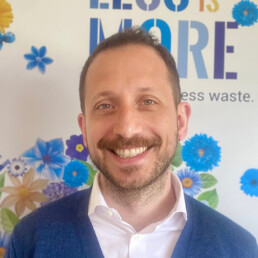Focus on sustainable design: the new EU packaging regulation sets high requirements for packaging recycling. Interzero explains how they can actually be sorted and recycled using its research-based 'Made for Recycling' packaging analysis.
20 out of a possible 20 points: with this result, Gualapack's 'Pouch 5' is a true recycling champion. The leading supplier of squeeze pouches has already had its packaging evaluated several times according to the Made for Recycling" analysis standard, thus obtaining important information on sustainable design: "With Pouch 5, we have developed the first stand-up pouch with a spout made of a single material - polypropylene - that is highly recyclable." - says Lorenzo Sacchi, head of sustainability at Italian company Gualapack S.p.A.. "Interzero's expertise has been, and continues to be, essential to us when testing recyclability."
Recyclability confirmed by seal and mark
Sustainable packaging has long since ceased to be merely an image factor. According to the European Commission, recyclability will soon be the deciding factor for packaging in the market. PPWR keyword: The new EU packaging regulation states that all packaging must be recyclable from 2030. "With Made for Recycling, we support our customers in determining the actual recyclability of their packaging, optimizing it when necessary and developing new, future-proof solutions." - says Frank Kurrat, Managing Director of the Interzero Recycling Alliance. "In this way, companies can also differentiate their packaging from their competitors in the long term."
An important argument in favour of Gualapack: unlike many other environmental claims, the 'Made for Recycling' label is based on clearly defined, scientific facts. The international standard for the recyclability of packaging is based on an assessment methodology developed by Interzero in cooperation with the bifa Umweltinstitut and confirmed by the Fraunhofer Institute for Process Engineering and Packaging IVV. Packaging is analysed at the Interzero Plastics Innovation competence centre in Slovenia - the first and so far only accredited research facility in the EU specialising in the development and analysis of recycled plastics. Specialists not only analyse the materials and design of packaging, but also assess the practical sorting and recycling infrastructure, which can vary considerably from country to country.

Monomaterial has an advantage
For Gualapack, the commitment to recycling has undoubtedly paid off. In 2021, the single-ply PP bag won the Best Packaging Award in Italy and is now used by major brands such as Nestlé and Kraft Heinz. "Pouch 5 is now our flagship product and accounts for about a third of our flexible packaging sales." - says Lorenzo Sacchi. In terms of quality, the single-plastic packaging is not inferior to the standard versions. They can be sterilised and pasteurised, making them suitable for yoghurt or baby food packaging, for example, and the outer layer can be easily printed with a branding. A distinct advantage of the single-plastic version is that, from production to recycling, it emits around 40 per cent fewer greenhouse gases than a standard bag - an added incentive for companies looking to reduce their carbon footprint.

